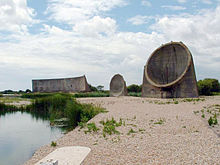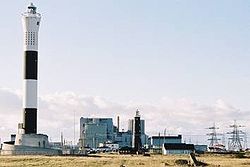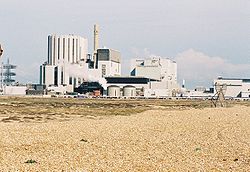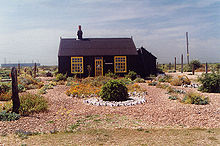- Dungeness (headland)
-
This article is about the headland in Kent, England. For the spit in Washington, United States, see Dungeness Spit. For the headland on the border of Chile and Argentina, see Punta Dúngeness.
Coordinates: 50°55′00″N 0°58′00″E / 50.916667°N 0.966667°E
Dungeness
 Dungeness shown within Kent
Dungeness shown within KentOS grid reference TR0917 Parish Lydd District Shepway Shire county Kent Region South East Country England Sovereign state United Kingdom Post town Romney Marsh Postcode district TN29 Dialling code 01797 Police Kent Fire Kent Ambulance South East Coast EU Parliament South East England UK Parliament Folkestone and Hythe Website http://www.dungeness.org.uk/ List of places: UK • England • Kent Dungeness is a headland on the coast of Kent, England, formed largely of a shingle beach in the form of a cuspate foreland. It shelters a large area of low-lying land, Romney Marsh. Dungeness is also the name given to a "village" situated along the beach, and to an important ecological site on the same location.
Contents
Etymology
The name Dungeness derives from Old Norse nes: "headland", with the first part probably connected with the nearby Denge Marsh. Popular etymology ascribes a French origin to the toponym, giving an interpretation as "dangerous nose".
Ecology
Dungeness is one of the largest expanses of shingle in the world. It is of international conservation importance for its geomorphology, plant and invertebrate communities and birdlife. This is recognised and protected mostly through its conservation designations as a National Nature Reserve (NNR), a Special Protection Area (SPA), a Special Area of Conservation (SAC) and part of the Site of Special Scientific Interest (SSSI) known as Dungeness, Romney Marsh and Rye Bay.
There is a remarkable and unique variety of wildlife living at Dungeness, with over 600 different types of plant (a third of all those found in Britain). It is one of the best places in Britain to find insects such as moths, bees and beetles, and spiders; many of these are very rare, some found nowhere else in Britain.
The short-haired bumblebee, Bombus subterraneus, declared extinct in the UK nearly a decade ago, but which has survived in New Zealand after being shipped there more than 100 years ago, is to be reintroduced at Dungeness. It is planned that the first bees will be introduced in the spring of 2010.
The flooded gravel pits, both brackish and fresh water, provide an important refuge for many migratory and coastal bird species. The RSPB has a bird sanctuary there and every year thousands of bird watchers descend on the peninsula to catch a glimpse of a rare bird from the bird observatory.
One of the most remarkable features of the site is an area known as 'the patch' or, by anglers, as 'the boil'. The waste hot water and sewage from the Dungeness nuclear power stations are pumped into the sea through two outfall pipes, enriching the biological productivity of the sea bed and attracting seabirds from miles around.
Lighthouses
There have been five lighthouses at Dungeness.
At first only a beacon was used to give warning to sailors, but this gave way to a proper lighthouse during the reign of James I in 1615. As the sea retreated, this had to be replaced in 1635 by a new lighthouse nearer to the water’s edge. As more shingle was thrown up, a new and more up-to-date lighthouse was built near the sea in 1792. In 1901 lighthouse number four was commissioned; then in 1961 its modern successor, the black and white lighthouse number five, was commissioned and the Old Lighthouse became a tourist attraction. Its 169 steps give visitors a bird’s eye view of the shingle beach.
Power stations
Main article: Dungeness nuclear power stationThere are two nuclear power stations at Dungeness, the first built in 1965 and the second in 1983. They are within a wildlife sanctuary deemed a Site of Special Scientific Interest and birds flourish in the warmer water created by the station's outflow.[citation needed]
The older power station closed on 31 December 2006,[1] while the newer station has had its licence extended to 2018.[2]
Tours of the power station stopped due to security fears after September 11, 2001. The visitors' centre closed in 2003, and the area is now used for offices.
Communications
Roads
There are two roads giving access: one from Lydd in the north-west; and from the north at New Romney along the coast.
Railways
Main article: Dungeness railway stationA branch from the Marshlink Line at Appledore to New Romney was opened by the South Eastern Railway: it had a short branch to a station at Dungeness, which closed to passengers on 4 July 1937; it was closed completely when the Lydd to New Romney section closed on 6 March 1967.[3] The remaining section to Lydd transports waste from the power stations. The track is shown on Ordnance Survey map sheet 89, and a number of cottages have been constructed from old carriages.
The Romney, Hythe and Dymchurch Railway, opened to New Romney in 1927, was extended to Dungeness a year later, and continues to operate.
Defence uses
The beach and marshes have been used for military training and there are marked Danger areas.
Acoustic mirrors
 Acoustic mirrors at Denge
Acoustic mirrors at Denge
Denge is the site of a set of acoustic mirrors, known as the "Listening Ears". Built between 1928 and 1930, the three massive concrete structures formed an experimental early warning system that aimed to detect invading aircraft by focusing sound waves. The site was chosen as being one of the quietest in Britain. Their different forms are evidence of their experimental nature; they were not particularly effective and were abandoned when radar became available. English Heritage and English Nature have joined forces to provide public access to the site.
Operation Pluto
In 1944 some of the world's first submarine oil pipelines were laid between Dungeness and France in Operation Pluto. The lines from Dungeness were part of a network called Dumbo and ran to Ambleteuse in France.
The "Village"
Dungeness is not truly a village, more a scattered collection of dwellings. Some of the homes, small wooden houses in the main, many built around old railway coaches, are owned and lived in by fishermen, whose boats lie on the beach; some are occupied by people trying to escape the pressured outside world. The shack-like properties have a high value on the property market.
Perhaps the most famous house is Prospect Cottage, formerly owned by the late artist and film director Derek Jarman. The cottage itself is painted black, with a poem, part of John Donne's "The Sunne Rising", written on one side in black lettering. The garden however is the main attraction. Reflecting the bleak, windswept landscape of the peninsula, Derek Jarman's garden is made of pebbles, driftwood, scrap metal and a few hardy plants. A book, Derek Jarman's Garden, is available, ISBN 0-500-01656-9.
The Village has two Public Houses "The Pilot" and "The Britannia", both serving seafood. There are more solidly-built houses around the site of the power stations. Fresh seafood can be purchased from several outlets across the shingle.
Landscape
The landscape is of relatively recent late mediaeval origin and was further altered when the marsh was drained and replaced by the large arable fields of industrial agriculture.[4]
The Dungeness area will potentially be affected by plans to lengthen the runway of London Ashford Airport to accommodate large passenger jets.
Media references
Dungeness has begun to appear regularly in music videos, album covers and adverts.
The album/project titled Bass Communion, (one of Porcupine Tree's frontman Steven Wilson's other bands/projects), features the T-shaped Shipping Marker. It is located near the fisherman's huts in Dungeness.
The acoustic mirror which can be found at Dungeness is featured on the cover of the album Ether Song by the British indie band Turin Brakes. Dungeness appears on the covers of albums as diverse as So much for the city by The Thrills and Aled by Aled Jones.
Athlete have a song on the album Vehicles and Animals called "Dungeness" which is about the area. Get Cape. Wear Cape. Fly mention Dungeness and the lighthouse in their song "Lighthouse Keeper". The Kent-based hardcore punk band November Coming Fire released a 2006 album entitled Dungeness, featuring a track called "Powerstation" which included a recording of waves on the beach. The Prodigy's single "Invaders Must Die" video was filmed here, and shows both the acoustic mirrors and the lighthouse.
In television, the Dungeness landscape, the light house and the power station have been used on digital channel E4 at the beginning and end of advertising breaks. It featured in an episode of the BBC detective serial The Inspector Lynley Mysteries and in March 2007 was the setting for a major part of an EastEnders special. The BBC filmed episodes of Doctor Who in Dungeness during the 1970s.
The 1981 fantasy film Time Bandits shot its 'Time of Legends' sequence on the beach and much of the 1998 Rachel Weisz movie I Want You was set in and around Dungeness, with the lead character's home being one of the wooden beach dwellings.
In the 2010 film Robin Hood, Dungeness is the landing point for King Phillip of France's siege on England, and the subsequent battle at the climax of the film. As it was not filmed there, the site on screen bears no resemblance to Dungeness at all.
The nuclear powerstation at Dungeness was mentioned in "I'm ebola" by the band The Stripper Project who live in nearby Hastings "...Im like a three-handed child in the shadow of Dungeness...where we can grow our extra toes.."
It was also featured in episode 5 of "Citizen Smith", as the location for an interview with the Rubbish men.[5]
See also
- Battle of Dungeness, a 1652 battle of the First Anglo-Dutch War
- Cuspate foreland
References
- ^ "England | Kent | Nuclear switch-off at Dungeness A". BBC News. 2006-12-31. http://news.bbc.co.uk/1/hi/england/kent/6203953.stm. Retrieved 2009-06-02.
- ^ "News". British Energy. http://www.british-energy.com/article.php?article=99. Retrieved 2009-06-02.
- ^ "history of the Dungeness railway line and pictures". Subbrit.org.uk. http://www.subbrit.org.uk/sb-sites/stations/d/dungeness/index.shtml. Retrieved 2009-06-02.
- ^ Liverpool University and Romney Marsh Research Trust web site linking ecology, geomorphology and human history in an accessible format for the non-specialist.
- ^ http://www.youtube.com/watch?v=sPUcieuSbqc&feature=related
External links
- dungeness-nnr.co.uk - Official site for Dungeness National Nature Reserve
- Dungeness Bird Observatory
- Images of Prospect Cottage on SlowMotionAngel.com
- Romney Marsh & Dungeness news & community website
- Dungeness acoustic mirrors
- Dungeness RNLI lifeboat
- Images of Dungeness
- PROSPECT - Dungeness-based art installation
Towns and villages in the Shepway district of Kent, England  Acrise · Arpinge · Beachborough · Bladbean · Bodsham · Breach · Brenzett · Brookland · Burmarsh · Cheriton · Danton Pinch · Densole · Dymchurch · Dungeness · Elham · Elmsted · Etchinghill · Folkestone · Frogholt · Greatstone-on-Sea · Hawkinge · Hythe · Ivychurch · Lade · Littlestone-on-Sea · Lydd · Lydd-on-Sea · Lyminge · Lympne · Monks Horton · Newchurch · Newingreen · Newington · New Romney · Old Romney · Paddlesworth · Pedlinge · Peene · Postling · Rhodes Minnis · Saltwood · Sandgate · Sandling · Sellindge · Selsted · Snargate · Stanford · Stelling Minnis · St Mary in the Marsh · St Mary's Bay · Westenhanger · West Hythe · WingmoreCategories:
Acrise · Arpinge · Beachborough · Bladbean · Bodsham · Breach · Brenzett · Brookland · Burmarsh · Cheriton · Danton Pinch · Densole · Dymchurch · Dungeness · Elham · Elmsted · Etchinghill · Folkestone · Frogholt · Greatstone-on-Sea · Hawkinge · Hythe · Ivychurch · Lade · Littlestone-on-Sea · Lydd · Lydd-on-Sea · Lyminge · Lympne · Monks Horton · Newchurch · Newingreen · Newington · New Romney · Old Romney · Paddlesworth · Pedlinge · Peene · Postling · Rhodes Minnis · Saltwood · Sandgate · Sandling · Sellindge · Selsted · Snargate · Stanford · Stelling Minnis · St Mary in the Marsh · St Mary's Bay · Westenhanger · West Hythe · WingmoreCategories:- Geography of Kent
- Headlands of England
- Lighthouses in England
- Villages in Kent
- Nature Conservation Review sites
- Special Areas of Conservation in England
- Unreferenced Kent-related articles
- Populated coastal places in Kent
Wikimedia Foundation. 2010.




